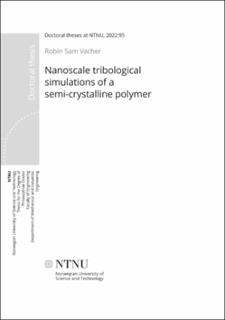| dc.contributor.advisor | de Wijn, Astrid | |
| dc.contributor.advisor | Nieto, Sergio Armada | |
| dc.contributor.author | Vacher, Robin Sam | |
| dc.date.accessioned | 2022-03-17T13:42:37Z | |
| dc.date.available | 2022-03-17T13:42:37Z | |
| dc.date.issued | 2022 | |
| dc.identifier.isbn | 978-82-326-5238-9 | |
| dc.identifier.issn | 2703-8084 | |
| dc.identifier.uri | https://hdl.handle.net/11250/2985898 | |
| dc.description.abstract | Many of the objects surrounding us are made of polymers. Those polymers are often used for their tribological properties, for example, shoes with rubber soles or car tyres. Polymers materials become more and more presents, and their frictional behaviour is often a significant issue. Macroscopic properties of those materials such as friction and wear have been intensely studied in the past. Those studies have shown that there are nontrivial effects in friction and wear specific to polymers, such as non-linearity and nontrivial temperature dependence. Much remains to be understood, as there are many additional complications in many realistic polymers that can affect the structure and friction, such as the strength of the interatomic interactions, cross-linking, or the presence of water and other contaminants.
We want to identify and investigate some of the main mechanisms of semicrystalline polymer friction. In that regard, molecular dynamic simulations are used to create semi-crystalline solid polymer substrates at the nanoscopic scale. We modelled a friction force microscope experiment. The polymer tends to coaxially align and form a layered structure during rubbing simulations directly under the tip. Over time, the plastic deformation on and near the surface builds up, the friction decreases, and the polymers in the top layer align with each other in the sliding direction.
A small amount of friction is often wanted in tribological systems because high friction is linked to high wear and large energy consumption. A way to reduce friction is to apply lubricants. We have put the focus of our study on graphene lubricant. One of our goals is to identify how adding a graphene layer helps reduce friction and wear. We found that the stiffness of the graphene membrane linked to the boundary condition has a substantial impact on the indentation depth.
The surface profiles are directly affecting the friction. We investigate the emergence of the roughness of a polymer material. We found that by compressing a solid PVA substrate, the roughness of the polymer self-affinity continues to change with increasing strain.We associate this phenomenon with the viscoelastic properties of the polymer.
While our simulations are for a specific polymer, the qualitative behaviour is likely to be general and present in other polymers. | en_US |
| dc.language.iso | eng | en_US |
| dc.publisher | NTNU | en_US |
| dc.relation.ispartofseries | Doctoral theses at NTNU;2022:95 | |
| dc.relation.haspart | Paper 1: Vacher, Robin Sam; de Wijn, Astrid S.. Nanoscale simulations of wear and viscoelasticity of a semi-crystalline polymer. Tribology letter 2021 ;Volum 69. s. - | en_US |
| dc.relation.haspart | Paper 2: Vacher, Robin Sam; de Wijn, Astrid S.. Nanoscale friction and wear of a polymer coated with graphene. Beilstein Journal of Nanotechnology 2022 | en_US |
| dc.relation.haspart | Paper 3: Vacher, Robin Sam; de Wijn, Astrid S.. Molecular-dynamics simulations of the emergence of surface roughness in a polymer under compression. Materials 2021 ;Volum 14.(23) s. - | en_US |
| dc.title | Nanoscale tribological simulations of a semi-crystalline polymer | en_US |
| dc.type | Doctoral thesis | en_US |
| dc.subject.nsi | VDP::Teknologi: 500 | en_US |
